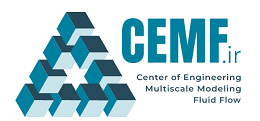A large portion of processing units in the industries involves multiphase flows, in which several phases coexist and interact with each other. The hydrodynamic interaction between phases is very important since it affect phase holdup, inter-phase mass and heat transfer. The complex behavior of these flows depends on operating conditions and physical properties of each phase. Perhaps one of the most known and common is fluidized bed, a gas-solid system (see an animation here). In the following you will learn about various types of basic modeling approach that we use for multiscale modeling of flows (Eulerian Model, CFD-DEM, VOF). These basic models are used for non-reactive multiphase flows.
Eulerian Model
Eulerian model is the most basic CFD-based multiphase model. For two-phase systems, it is called two fluid model (TFM) and for multiphase system, multi- fluid model (MFM). Eulerian model considers all the coexisting phases as continuous phases which interact with each other. So, the interface between phases are not resolved and averaged values (cell based) are used for field variables of each phase with continuity and Navier-Stokes equations. This modeling approach can be used for lab-scale to industrial scale simulations. In industrial scale simulation, the mesh/solution resolution is not very fine. Therefore, we use some special treatments to capture fine-grained flow structures.
CFD -DEM
CFD-DEM is an special two-phase model for gas-solid and liquid-solid flows. The gas/liquid phase is considered as a continuous phase with continuity and Navier-Stokes equations. However, solid phase is assumed to contain individual solid particles (as it happens in real world). The motion of each individual particle is tracked in time and space to obtain phase flow behavior. Fluid-phase and solid phase interact with each other trough surface forces. Two main roots of this modeling approach are resolved and unresolved CFD-DEM.
In resolved CFD-DEM, the flow around each particle is resolved to obtain the exact and detailed flow field around particles. This is precise approach requires large resources of computation, which restricts it to lab-scale simulations. In unresolved CFD-DEM, the flow is averaged over domains (cells) which contains particles and the averaged phase volume fraction and interaction parameters appear in continuity and momentum equations. Here, required computation cost is much lower than resolved CFD-DEM, makes it possible to be applied for lab-scale to pilot scale applications. Some methods like coarse graining are used to further expand the model for industrial scale applications.
Volume of Fluid (VOF)
Volume of fluid can achieve further resolution refinement for a multiphase flow, specifically gas-liquid or liquid-liquid. The interface between phases are tracked trough mesh refinement. This allows us to better simulate phase behavior and understand phase transport phenomena. The mesh refinement is computationally very expensive, so this restricts VOF to lab-scale simulations. Dynamic mesh refinement is an enhancement over the mesh refinement, in which a coarse mesh is used for the whole domain and mesh is refined in the interface between phases. The dynamic mesh refinement is requires less computation resources.
Reactive Multiphase Flows
Most of multiphase flows involve reaction in one or more phases or even at the phase interface. As an example for processes with reactive multiphase flows, we can name gas phase polymerization reactions of olefins in which a heterogeneous polymerization between gas phase and live polymeric particles occurs (on the interface). The slurry phase polymerization reactions involve solution of monomers and other component into the slurry phase and polymerization reaction in the slurry phase. This process involves simultaneous evaporation of solvent. Therefore, phase equilibrium play a critical rule in the model. Catalytic reforming of hydrocarbons is another example where surface reforming reactions occur on the catalyst surface. Combustion of coal and other reduction reactions occurs between gas and solids. In this furnace, radiation heat transfer is an factor in addition to other factors.
The basic cold fluid models contain continuity and momentum transfer models which provide phase fraction, velocity and pressure fields of the flow. All the basic cold fluid flow models (TFM, CFD-DEM or VOF) can be expanded to be applied for reactive muliphase flows for which many applications can be found in process industries. A complete model for a reactive mulitphase flow should contain intra-phase specie and energy models, inter-phase specie and heat transfers models, thermodynamic model for phase equilibrium, reaction kinetic models, phase turbulence models, and etc.
We use programming tools to develop new codes (solvers) for reactive multiphase flows . The solvers can simulated slow, moderate, or fast (stiff ODEs) reacting systems. Phase equilibrium equations also accompany these solvers wherever applicable. Population balance models for dispersed phases properties such as bubble size, particle size are other models that can be included in the reactive flow solvers. Some of the reactive systems contains complex kinetic schemes such as polymerization chain reactions. These solvers can also simulate polymerization reaction systems.
